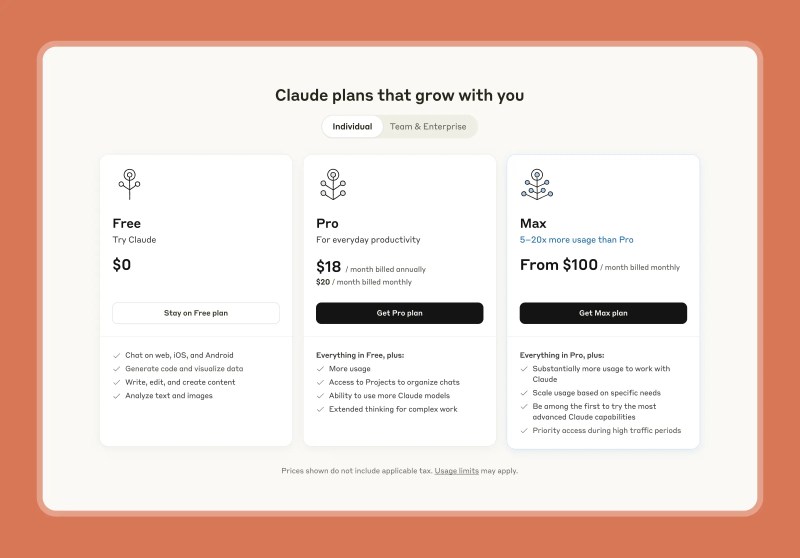
Join our daily and weekly newsletters for the latest updates and exclusive content on industry-leading AI coverage. Learn More
Anthropic introduced a new high-end subscription tier for its Claude chatbot today, directly challenging OpenAI’s premium offerings and marking the latest escalation in the race to monetize powerful AI models amid soaring development costs.
The new “Max” plan offers professionals two pricing options: $100 per month for five times the usage of Anthropic’s existing $20 Pro plan, or $200 per month for twenty times the usage. The move mirrors OpenAI’s $200 monthly ChatGPT Pro subscription but adds a less expensive middle tier for those who need more than the basic plan but not the full premium experience.
This tiered approach shows Anthropic understands how AI is changing professional work. Many users now see Claude as a constant collaborator, not just an occasional tool. The $100 tier serves professionals who use Claude regularly but don’t need full enterprise access. The $200 tier is for those who rely on Claude throughout their workday.
The launch comes as AI companies search for sustainable business models to offset the enormous costs of developing and running increasingly powerful large language models. The latest generation of AI systems, including Anthropic’s recently released Claude 3.7 Sonnet, requires vast amounts of computing resources both for training and everyday operation.

Power users and premium pricing: The economics behind Claude’s $200 tier
For the small but growing cohort of “power users” — professionals who have integrated AI assistants deeply into their daily workflows — hitting usage limits represents a significant productivity bottleneck. The Max plan targets these users, particularly those who expense AI tools individually rather than accessing them through company-wide enterprise deployments.
The pricing strategy reveals a fundamental shift in how AI companies view their customer base. What began as experimental technology is rapidly stratifying into distinct market segments with dramatically different usage patterns and willingness to pay. Anthropic’s tiered structure acknowledges this reality: casual users can access basic capabilities for free, professionals with moderate needs pay $20 monthly, power users requiring substantial resources invest $100-$200 monthly, and enterprises negotiate custom packages.
This segmentation creates a critical “missing middle” solution. Until now, there’s been a vast chasm between individual subscriptions and enterprise contracts, leaving small teams and departments without right-sized options. The $100 tier particularly fills this gap, enabling team leads to expense meaningful AI resources without navigating complex procurement processes.
The $200 price point represents a significant bet on AI’s growing indispensability. Few professionals would have considered such an expense justifiable a year ago, but as these systems become embedded in daily workflows, the calculus changes dramatically. For a marketer, developer, or analyst billing clients at $150+ hourly, Claude’s ability to accelerate projects by even 10% represents an obvious return on investment.
Early access privileges: How Anthropic’s feature pipeline entices premium subscribers
Beyond higher usage limits, Max subscribers will receive priority access to upcoming features before they roll out to other users. This includes Claude’s voice mode, expected to launch in the coming months, according to the company.
This approach reveals Anthropic’s sophisticated product development strategy. Rather than simply charging more for existing capabilities, the company is creating a premium experience that combines higher capacity with innovation privileges. This mirrors strategies used by companies like Tesla, which offers premium customers early access to new autopilot features, creating tangible status value beyond raw specifications.
The voice mode tease is particularly significant. Voice interaction represents the next frontier in AI assistance, potentially transforming how professionals engage with Claude throughout their workday. The ability to verbally brief Claude on contexts, request analyses while multitasking, or receive spoken summaries while commuting could dramatically expand the assistant’s utility in professional settings.
For Anthropic, this exclusive access model serves multiple purposes: it creates powerful incentives for upgrades, establishes a controlled testing environment for new features, and generates valuable feedback from its most engaged users. The company essentially creates a revenue-generating beta program where customers pay for the privilege of shaping product development—a remarkably efficient approach to innovation.
Perfect timing: Claude 3.7 Sonnet’s launch creates ideal runway for premium pricing
The Max plan’s launch follows just weeks after Anthropic released Claude 3.7 Sonnet, which the company describes as its “most intelligent model to date” and its first “reasoning model” — designed to use more computing power for more reliable answers to complex questions.
This sequencing reveals Anthropic’s savvy product marketing strategy. By first demonstrating Claude 3.7 Sonnet’s superior capabilities — particularly in reasoning, coding, and complex information processing — the company created market desire before introducing the premium pricing that makes these advanced features economically sustainable.
The reasoning model approach represents a significant technological advancement worth examining. Unlike traditional language models that balance performance across diverse tasks, reasoning models allocate additional computational resources to problems requiring structured thinking and logical analysis. This creates a qualitatively different experience for users tackling complex challenges — an experience Anthropic now argues justifies premium pricing.
Dario Amodei, Anthropic’s CEO, alluded to the company’s growing revenue during a CNBC interview in January, though exact figures remain private. Industry sources estimate Anthropic’s annualized revenue hit approximately $1 billion in December 2024, representing nearly tenfold growth year-over-year. The company closed its latest funding round last month at a $61.5 billion valuation.
For comparison, OpenAI reportedly told investors its annualized revenue grew by $300 million within just two months of launching ChatGPT Pro, according to documents viewed by TechCrunch. These figures suggest the market for premium AI services is expanding rapidly, with customers demonstrating clear willingness to pay for higher quality and greater capacity.
Working with AI all day: How professionals are reimagining their workflows around Claude
Anthropic has identified three primary use cases driving high usage: automating repetitive tasks, enhancing capabilities within existing roles, and enabling professionals to expand into new areas.
These patterns reflect a fundamental transformation in knowledge work that remains underappreciated by casual observers. We’re witnessing the emergence of “AI-augmented professionals” — workers who have fundamentally reinvented their processes around continuous collaboration with AI systems. For these individuals, Claude isn’t an occasional assistant but an always-present thought partner, draft generator, and analytical engine working alongside them throughout their day.
In practical terms, these translate to scenarios like a marketer using Claude to generate and refine multiple campaign variations, a developer maintaining continuous dialogue while debugging complex code, or a researcher processing substantial documents to extract patterns and insights.
The economics of these use cases justify premium pricing in ways that weren’t obvious even six months ago. The productivity gained from uninterrupted AI collaboration can be substantial — often transforming what would be multi-day projects into hours-long sessions. For professionals whose time is valued at hundreds of dollars hourly, removing artificial constraints on this collaboration represents a compelling business case.
While OpenAI’s ChatGPT Pro offers unlimited usage, Anthropic has opted for defined, though substantially higher, usage limits. This approach reflects both technical realities and business strategy. Truly unlimited AI usage presents genuine scaling challenges, while tiered limits create natural upgrade paths as users’ needs evolve. The company’s refusal to rule out even higher-priced tiers suggests they recognize some segment of the market may require — and willingly pay for — even greater capacity.
The maturing AI market: What Claude’s new tiers signal for the future of AI business models
The introduction of premium tiers by leading AI companies signals a maturing market where different user segments receive tailored offerings at corresponding price points. The $20-per-month casual professional user, the $100-$200 power user, and the enterprise client with custom needs represent distinct market segments with different expectations and willingness to pay.
This evolution perfectly parallels historical patterns in enterprise software development. Adobe’s transition from one-time purchases to Creative Cloud subscriptions, Microsoft’s evolution from boxed Office to 365 tiers, and Salesforce’s increasingly complex pricing matrix all followed similar trajectories as they became essential to their respective industries. AI appears to be compressing this evolution into months rather than years—a testament to how quickly these tools have become business-critical.
The fascinating question is whether AI will ultimately follow traditional SaaS pricing patterns or develop entirely new economic models. The compute-intensive nature of generative AI creates fundamentally different cost structures than traditional software. While the marginal cost of serving an additional user in traditional SaaS approaches zero, each additional AI interaction represents meaningful computational expense. This reality may eventually push the industry toward more consumption-based pricing models resembling cloud computing rather than flat subscription tiers.
For businesses evaluating AI investments, the emergence of these tiers provides welcome flexibility. Small teams can now access significantly more AI resources without committing to organization-wide contracts, while individuals with specialized needs can justify premium subscriptions through tangible productivity gains. This growing range of options signals AI’s transition from experimental technology to essential business infrastructure — a transition that brings both higher prices and higher expectations for measurable return on investment.
For now, the race between Anthropic, OpenAI, and other AI providers continues to intensify as they compete for both consumer attention and enterprise dollars. With development costs still enormous and the path to sustainable profitability unclear, premium subscriptions represent a crucial revenue stream as these companies work to transform promising technology into viable businesses.
Source link






